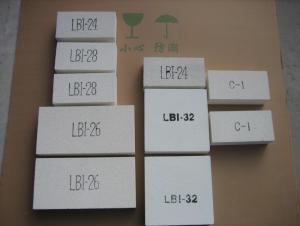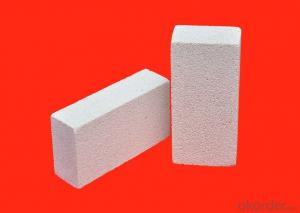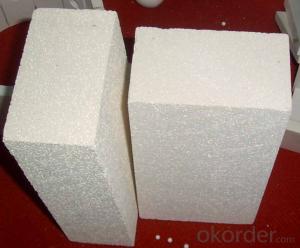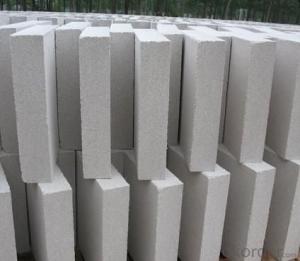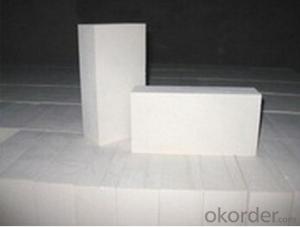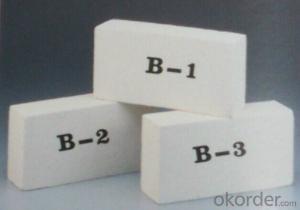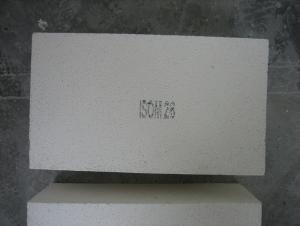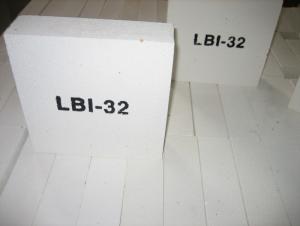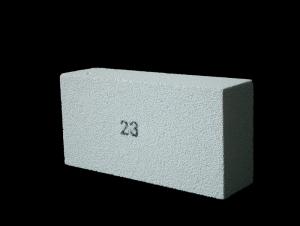Insulating Fire Brick - Refractory Mullite Insulating Refractory Brick JM 24
- Loading Port:
- Shanghai
- Payment Terms:
- TT OR LC
- Min Order Qty:
- 20 m.t.
- Supply Capability:
- 20 m.t./month
OKorder Service Pledge
OKorder Financial Service
You Might Also Like
Okorder series heat insulation brick
Okorder series thermal insulation brick is an effective, energy saving, low carbon, environmental protection advanced, according to the ASTM standard manufacturing products. Okorder series products have all kinds of materials in the field of metallurgy, industrial furnaces, aluminum, the best Li Ning petrochemical and insulation, electric power and glass ceramics. They can be used as part of an insulation or not to melt. Products have been widely used in the following furnace, achieved satisfactory results.
Application of heat preservation brick
Metallurgical Industry: blast furnace, hot blast furnace, heating furnace, etc..
Petrochemical Industry: ethylene cracking furnace, hydrogen furnace, the main furnace, heating furnace, etc..
Ceramic industry: roller kiln, kiln, etc..
Glass industry: glass furnace regenerator, etc.
Carbon industry: carbon furnace, etc..
Aluminum electrolysis industry: aluminum reduction cell, etc.
Other industries: tunnel kiln, shuttle kiln, etc..
Advantages of heat insulation brick
Low thermal conductivity: many air holes will bring good thermal insulation effect, energy saving.
High crushing strength: high crushing strength, volume stability.
Low heat storage: small heat storage, absorb more heat, energy-saving effect is obvious.
Chundu: High-speed Rail, low content of alkali metal impurities.
Accuracy: the size of the brick machining precision, cutting and grinding the special shape, speed up the brick.
Technical Data
ITEM | GJM30 | GJM28 | GJM26 | GJM23 |
Classification Temperature, ℉/℃ | 3000/1650 | 2800/1540 | 2600/1430 | 2300/1260 |
Bulk Density,g/cm³ | ≤1.0 | ≤0.9 | ≤0.8 | ≥0.5 |
Reheating Linear Change, % | ≤0.9 (1550℃,12 h) | ≤0.8 (1510℃,12 h) | ≤0.7 (1410℃,12 h) | ≤0.5 (1230℃,12 h) |
Al2O3 Content, % | ≥75 | ≥65 | ≥55 | ≥45 |
Fe2O3 Content, % | ≤0.5 | ≤0.6 | ≤0.7 | ≤1.0 |
Thermal Conductivity: | ||||
800℃, w/m.k | ≤0.39 | ≤0.37 | ≤0.35 | ≤0.18 |
1000℃, w/m.k | ≤0.43 | ≤0.41 | ≤0.39 | ≤0.20 |
1200℃, w/m.k | ≤0.48 | ≤0.46 | ≤0.43 | --- |
Insulating brick
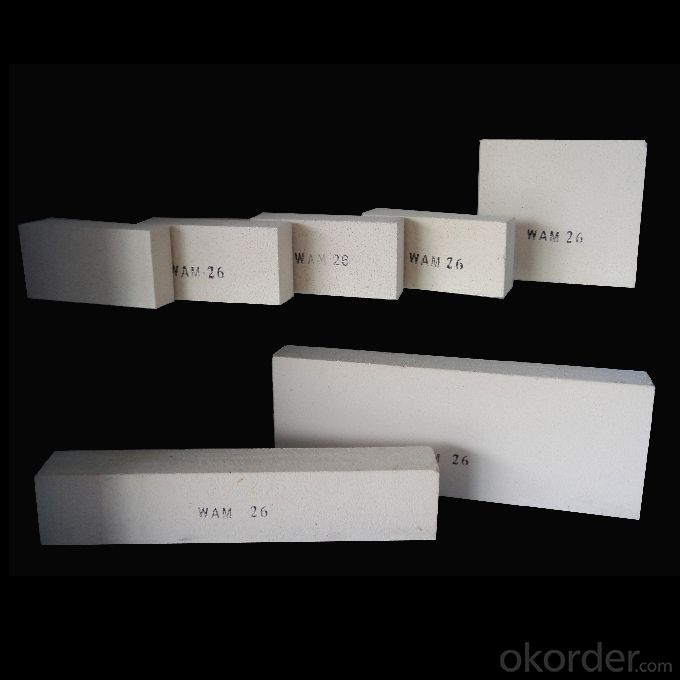
- Q: Can insulating fire bricks be used in high-velocity gas flow applications?
- Yes, insulating fire bricks can be used in high-velocity gas flow applications. Insulating fire bricks are designed to have excellent thermal insulation properties, low thermal conductivity, and high resistance to temperature fluctuations. These characteristics make them suitable for various high-temperature applications, including high-velocity gas flow environments. When exposed to high-velocity gas flow, insulating fire bricks can maintain their structural integrity and insulation properties, providing effective thermal insulation and protection. They are often used in applications such as kilns, furnaces, boilers, and other industrial equipment where high-velocity gas flow is present. However, it is important to consider the specific requirements and characteristics of the gas flow in the application. Factors such as temperature, pressure, and chemical composition of the gas should be taken into account to ensure that the insulating fire bricks are compatible and can withstand the conditions. In summary, insulating fire bricks can be used in high-velocity gas flow applications due to their thermal insulation properties and resistance to temperature fluctuations. However, it is crucial to consider the specific requirements and characteristics of the gas flow to ensure proper compatibility and performance.
- Q: Are insulating fire bricks resistant to chemical attack?
- Yes, insulating fire bricks are generally resistant to chemical attack. They are designed to withstand high temperatures and are made from materials that are chemically inert, making them suitable for various industrial applications where exposure to chemicals is a concern. However, the specific resistance may vary depending on the type of chemical and concentration, so it is important to consider the specific chemical environment when selecting insulating fire bricks.
- Q: Are insulating fire bricks suitable for insulation in boilers?
- Insulating fire bricks prove to be a suitable option for insulation in boilers. Made from lightweight materials like clay and alumina, these bricks possess exceptional insulation properties. With their low thermal conductivity, they effectively impede heat transfer and significantly diminish heat loss in boilers. Moreover, insulating fire bricks exhibit resistance towards high temperatures, making them ideal for boilers that generate intense heat. They are also durable, capable of enduring the harsh conditions found within boilers, including exposure to corrosive gases and intense heat. Ultimately, the thermal efficiency and high-temperature endurance of insulating fire bricks make them a popular choice for boiler insulation.
- Q: Are insulating fire bricks resistant to fire?
- Yes, insulating fire bricks are specifically designed to be highly resistant to fire. They have excellent insulating properties and can withstand high temperatures without cracking or breaking down.
- Q: What is the compressive strength of insulating fire bricks?
- The compressive strength of insulating fire bricks can vary depending on the specific composition and manufacturing process. However, in general, insulating fire bricks have a compressive strength ranging from 1 MPa (megapascal) to 10 MPa. This range is relatively low compared to other types of bricks due to their lightweight and porous nature, which is designed to provide excellent thermal insulation properties. It is important to note that the compressive strength of insulating fire bricks may not be as crucial as in structural bricks, as their main function is to provide insulation rather than structural support.
- Q: Are insulating fire bricks suitable for insulation in cryogenic applications?
- Insulating fire bricks are indeed appropriate for insulation in cryogenic applications. These bricks are crafted from lightweight refractory materials that possess exceptional thermal insulation qualities. With their low thermal conductivity, high melting points, and ability to withstand extremely frigid temperatures, they are perfectly suited for cryogenic applications. Cryogenic applications entail the handling and storage of materials at exceedingly low temperatures, typically below -150 degrees Celsius (-238 degrees Fahrenheit). Insulating fire bricks are specifically designed to provide efficient insulation in such extreme conditions, effectively preventing heat transfer and maintaining the desired low temperature. Moreover, insulating fire bricks exhibit chemical stability and possess excellent resistance to thermal shock. This means they can endure rapid temperature fluctuations without cracking or deteriorating, which is particularly crucial in cryogenic applications where such variations are commonplace. In addition to their exceptional thermal insulation qualities, insulating fire bricks are lightweight and easy to handle, making them convenient for installation in cryogenic systems. All in all, insulating fire bricks are a suitable choice for insulation in cryogenic applications due to their thermal insulation properties, resistance to high temperatures, chemical stability, and ability to withstand thermal shock.
- Q: Can insulating fire bricks be used in the construction of fireplaces?
- Insulating fire bricks are a viable option for fireplace construction. These bricks are specifically designed to endure high temperatures, making them perfect for lining the inside of a fireplace. Their exceptional thermal insulation capabilities ensure that heat is contained within the fireplace, preventing excessive heat transfer to the surrounding structure. This not only enhances the efficiency of the fireplace but also reduces the likelihood of damage to nearby walls. Furthermore, these bricks are lightweight and easy to work with, making them convenient for construction purposes. They are also resistant to thermal shock, meaning they can withstand sudden temperature changes without cracking or breaking. Overall, insulating fire bricks are a dependable and efficient choice for building fireplaces.
- Q: What is the typical compressive strength of an insulating fire brick?
- The compressive strength of an insulating fire brick typically varies due to differences in composition and the process used for manufacturing. On average, these bricks have a compressive strength that falls between 1,000 pounds per square inch (psi) and 3,000 psi. They are specifically engineered to endure extreme temperatures and offer thermal insulation in a range of applications, including kilns, furnaces, and fireplaces. The ability of these bricks to withstand crushing and uphold their structural integrity while under load is directly influenced by their compressive strength, making it a crucial characteristic.
- Q: Do insulating fire bricks have a high resistance to creep?
- Yes, insulating fire bricks generally have a high resistance to creep. The low thermal conductivity and high refractoriness of these bricks allow them to withstand high temperatures without significant deformation or creep.
- Q: Do insulating fire bricks require special storage conditions?
- Yes, insulating fire bricks do require special storage conditions. They should be stored in a dry and well-ventilated area to prevent moisture absorption, which can lead to cracking or spalling during use. Additionally, they should be protected from extreme temperatures and direct sunlight, as these can affect their integrity and performance.
Send your message to us
Insulating Fire Brick - Refractory Mullite Insulating Refractory Brick JM 24
- Loading Port:
- Shanghai
- Payment Terms:
- TT OR LC
- Min Order Qty:
- 20 m.t.
- Supply Capability:
- 20 m.t./month
OKorder Service Pledge
OKorder Financial Service
Similar products
Hot products
Hot Searches
Related keywords
